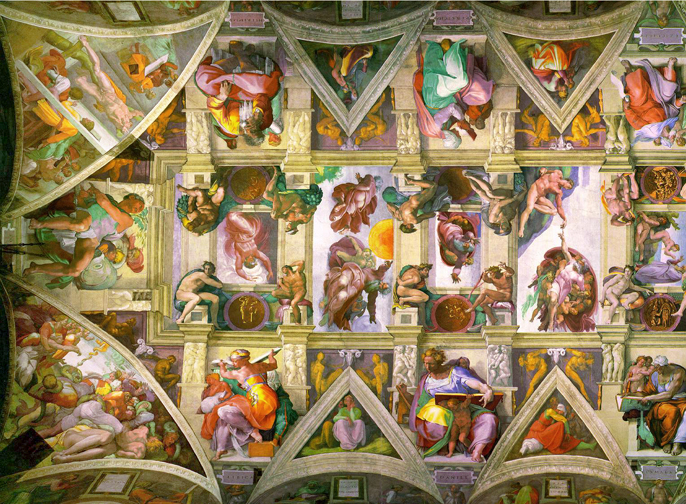Online Edition:
December 2012
Vol. XVIII, No. 9
The Sistine Chapel: A Story of Light and Salvation

Sistine Ceiling (detail) Fresco, 1504-1512. Michelangelo Buonarroti (1475-1564)
The 500th anniversary of Pope Julius II’s inauguration of Michelangelo’s ceiling frescoes in the Sistine Chapel was commemorated at first Vespers of All Saints on the evening of October 31, with Pope Benedict XVI presiding. The ceiling frescoes were begun in 1508 and completed in 1512.
Pope Benedict XVI spoke about the liturgical significance of the historic event, and about the ceiling frescoes that illustrate nine principal events in creation history recounted in the Book of Genesis.
The most famous of these ceiling frescoes is God creating Adam, transmitting life to him by touching Adam’s outstretched finger. Of this image, Pope Benedict said, “in that encounter of the finger of God and the finger of man, we perceive a contact between heaven and earth. In Adam, God entered into a new relationship with His creation.”
A liturgical celebration of the event is appropriate, the pope said, “because the Sistine Chapel is, by its nature, a place of liturgy, the ‘Cappella magna’ of the Vatican Apostolic Palace. Furthermore, because the works of art that decorate it, especially the cycle of frescoes, find in the liturgy their living environment, the context in which they best express all their beauty, their richness and their fullness of meaning…. In brief, the Sistine Chapel, contemplated in prayer, becomes even more beautiful, more authentic; it is revealed in all its richness.”
Pope Benedict mentioned that the Last Judgment fresco, on the wall behind the altar, was completed about 20 years after the ceiling. Michelangelo’s massive work shows “the great parable of the journey of humanity,” which leads to “the definitive encounter with Christ, the judge of the living and the dead,” the pope said.
The Holy Father noted that the artist and historian Giorgio Vasari (1511-74) accorded particular significance to Michelangelo’s Sistine Chapel: “In a famous passage of the Lives, [Vasari] wrote very effectively: ‘This work was and is truly the lamp of our art that gave so much benefit and light to the art of painting, which has been sufficient to illuminate the world.’” Pope Benedict explained further that “the light comes not only from the skillful use of color, or from the movement that animates Michelangelo’s masterpiece, but from the idea that permeates the great vault: it is the light of God which illuminates these frescoes, and indeed the entire chapel … that light whose power conquers chaos and obscurity, bringing light through creation and redemption. The Sistine Chapel narrates this story of light, of liberation, of salvation; it speaks of God’s relationship with humanity.
“With Michelangelo’s work of genius, our gaze is drawn to the message of the Prophets, to the pagan Sybils awaiting Christ, and finally to the origin of all: ‘In the beginning God created Heaven and Earth.’ With a unique expressive intensity, the great artist depicted God the Creator, His action, His power, to show that the world is not the product of obscurity, of chance or of the absurd, but that it derives from intelligence, freedom and from a supreme act of love. In that encounter between the hand of God and the hand of Adam, we perceive the contact between heaven and earth; in Adam God enters into a new relationship with His creation, and man is in direct contact with God, is called by Him, and is the image and likeness of God.
“To pray this evening in the Sistine Chapel, enveloped in the history of God’s journey with man, admirably represented in the frescoes above and around us, is an invitation to worship,” Pope Benedict said; “an invitation to raise to God the Creator, Redeemer and Judge of the living and of the dead, with all the Saints of Heaven, the words of the canticle of Revelation [19:4a.5.7a]: ‘Amen, alleluia…. Praise our God, all you His servants, you who fear Him, small and great! … Alleluia…. Let us rejoice and exult and give Him the glory.” — hhh
***
*



